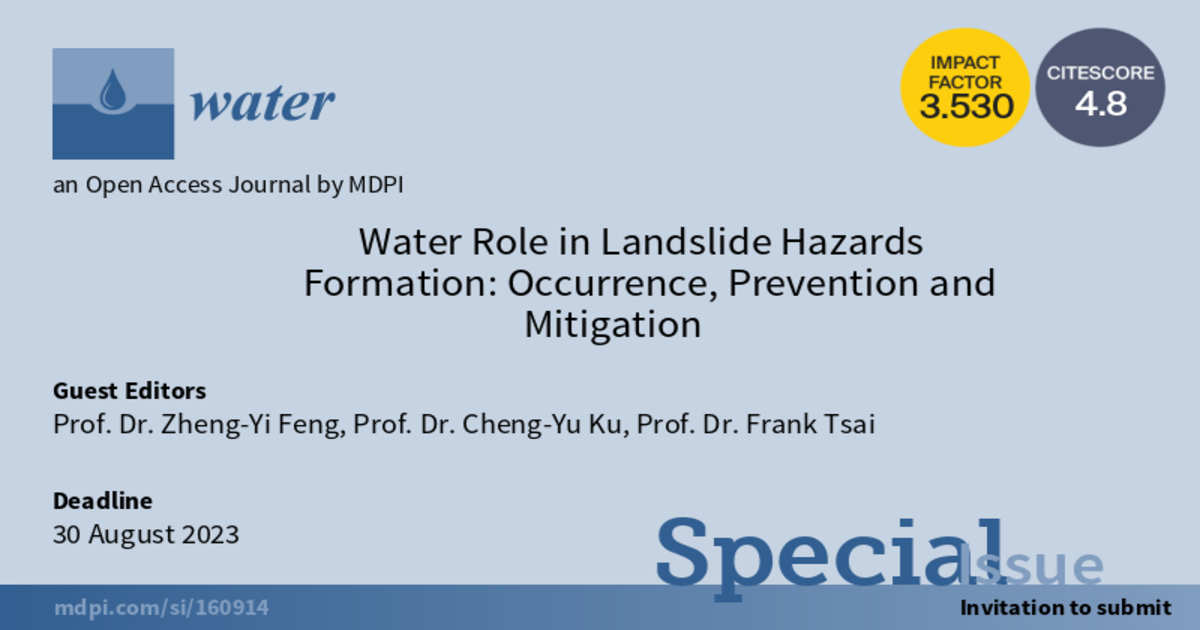Water Role in Landslide Hazards Formation: Occurrence, Prevention and Mitigation
A special issue of Water (ISSN 2073-4441). This special issue belongs to the section "Water Erosion and Sediment Transport".
Deadline for manuscript submissions: closed (30 August 2023) | Viewed by 5089

Special Issue Editors
Interests: landslides; debris flow; slope stability; earth dam; dam breach; riverbank erosion; dynamic analysis; seismic signal process; geotechnical engineering
Special Issues, Collections and Topics in MDPI journals
Interests: numerical methods; geotechnical engineering; groundwater modeling; groundwater; landslides modeling; slope stability; engineering geology
Special Issues, Collections and Topics in MDPI journals
Interests: groundwater; hydrogeology; surface and groundwater interactions; subsurface characterization; riverbank seepage; uncertainty analysis
Special Issues, Collections and Topics in MDPI journals
Special Issue Information
Dear Colleagues,
Frequently, landslide hazards are caused by water, such as soil slump, debris flow, debris flood, avalanche, lateral spreading, landslide dam burst, etc. The prevention and mitigation of landslide hazards are needed to reduce losses. For this end, the water’s role in landslide hazards formation shall be first investigated and understood in order to commence further effective prevention and mitigation designs for landslide hazards.
In this Special Issue, papers focused on landslide hazards induced by water are welcomed. Research methods using numerical, field investigation, experimental and theoretical approaches to advance the understanding of landslide hazards formation are all encouraged. We also appreciate new techniques for monitoring, risk assessment, prewarning, prevention and mitigation.
Prof. Dr. Zheng-Yi Feng
Prof. Dr. Cheng-Yu Ku
Prof. Dr. Frank Tsai
Guest Editors
Manuscript Submission Information
Manuscripts should be submitted online at www.mdpi.com by registering and logging in to this website. Once you are registered, click here to go to the submission form. Manuscripts can be submitted until the deadline. All submissions that pass pre-check are peer-reviewed. Accepted papers will be published continuously in the journal (as soon as accepted) and will be listed together on the special issue website. Research articles, review articles as well as short communications are invited. For planned papers, a title and short abstract (about 100 words) can be sent to the Editorial Office for announcement on this website.
Submitted manuscripts should not have been published previously, nor be under consideration for publication elsewhere (except conference proceedings papers). All manuscripts are thoroughly refereed through a single-blind peer-review process. A guide for authors and other relevant information for submission of manuscripts is available on the Instructions for Authors page. Water is an international peer-reviewed open access semimonthly journal published by MDPI.
Please visit the Instructions for Authors page before submitting a manuscript. The Article Processing Charge (APC) for publication in this open access journal is 2600 CHF (Swiss Francs). Submitted papers should be well formatted and use good English. Authors may use MDPI's English editing service prior to publication or during author revisions.
Keywords
- landslide
- debris flow
- hydrogeology
- failure mechanism
- slope stability
- groundwater seepage
- numerical analysis
- modeling
- experimental investigation
- monitoring
- mitigation
- pore-water pressure
- water table
- soil strength
- rock mass strength
- geo-hazard
- geological engineering
- remote sensing
- land use
Benefits of Publishing in a Special Issue
- Ease of navigation: Grouping papers by topic helps scholars navigate broad scope journals more efficiently.
- Greater discoverability: Special Issues support the reach and impact of scientific research. Articles in Special Issues are more discoverable and cited more frequently.
- Expansion of research network: Special Issues facilitate connections among authors, fostering scientific collaborations.
- External promotion: Articles in Special Issues are often promoted through the journal's social media, increasing their visibility.
- Reprint: MDPI Books provides the opportunity to republish successful Special Issues in book format, both online and in print.
Further information on MDPI's Special Issue policies can be found here.







